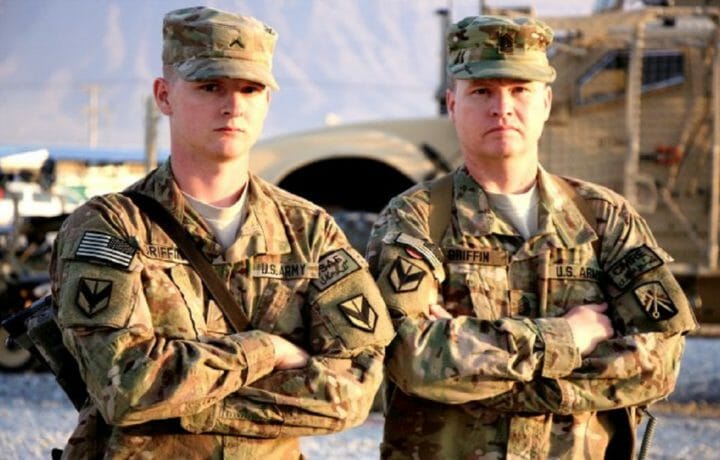“A soldier will fight long and hard for bit of colored ribbon.” – Napoleon Bonaparte
On a humid August morning outside our battalion headquarters at Fort Campbell, I stood with a gaggle of others waiting to form up for an awards ceremony. A warm wind wafted across the parade field, carrying the scent of the lunch meal from the nearby dining facility. It was 1991, over a year since the phone first rang, alerting me to report to Campbell Army Airfield and prepare for deployment to Saudi Arabia. As the battalion commander and command sergeant major made their way through the formation, we were each presented with what the Army euphemistically refers to as “shoulder sleeve insignia – former wartime service.” Our combat patches for Operation Desert Storm.
In the years that followed, I came to learn how much that simple patch meant to so many. In some ways, it was a rite of passage in the profession of arms, almost a symbol of one’s induction into the warrior caste. It demanded a certain level of respect, regardless of whether that respect had actually been earned. In an army in the midst of drawdown, combat patches were increasingly rare, and those who had earned them tended to wear them with a certain amount of pride.
Fast forward a generation, and to some, combat patches come across like “pieces of flair.” When it seems like everybody has one, do they really mean that much? Many argue that in the Army of today, a binary symbol of combat service isn’t an accurate measure of someone’s full contribution. Others still will decry “slick sleeves” – a not uncommon derogatory reference to servicemembers without wartime service – as not having met the true “bar” for veteran status.
The risk of combat patch culture
In truth, the venerable combat patch has always been a source of mixed messages. By itself, the combat patch doesn’t necessarily indicate actual combat service, a point of some importance lost on many. Most of us know someone who has earned a combat patch without ever setting eyes on an enemy combatant. Many more still know someone who has earned a combat patch without setting foot in an area of operations where active combat operations were taking place. Quite honestly, there is little value in checking sleeves for the presence of combat patches.
Truth be told, I’m as guilty as anyone of falling into this trap, and it seemed to get worse the more times I deployed. Walking the halls of the Pentagon, I would sneer at the “colonels without combat patches” I saw lumbering through the A Ring (I inevitably perceived them as shameful little trolls). I wouldn’t allow myself the time to view the whole person, but instead dismiss them out of course because they weren’t wearing a combat patch. In the same vein, I’d freely acknowledge those with a patch on their right sleeve.
We allow ourselves to succumb to a “combat patch culture” at our own risk. While on the surface they are a symbol of some significance, there are any number of measures of individual service contribution and accomplishment that are similarly overrated. Awards are one such measure, but they are often subjective, and the standards applied may vary significantly between commands. Badges earned as a result of combat service can also be similarly tarnished.
Whether or not we want to admit it, our culture is obsessed with pieces of flair. Combat patches are simply one symptom of that obsession. Of the five combat patches I earned during my career, I typically wore my Screaming Eagle from two combat tours with the 101st Airborne Division; that it also carried more “cool points” was a plus. Earning a Bronze Star medal during the Gulf War meant something in its day, but when they became “TOC passes” for the masses, maybe not so much. Earning a Combat Action Badge was meaningful until word spread that the “badge collectors” were amassing their own by just submitting the paperwork; no need to expose yourself to direct fire when a well-worn Skillcraft pen will get the job done.
What’s Carried in a Combat Patch
Combat patches are a part of our heritage. They invoke the memories of war, those all-too-familiar moments of nostalgia we all share. They elicit memories of people lost to the years, embodying something greater than ourselves but in a very human sense. They remind us of trials and tribulations, of hard times and loss. The legendary bluesman B.B. King once sang, “I used to sing spirituals and I thought that this was the thing that I wanted to do. But, somehow or other, when I went into the Army, I picked up Lucille and started singing the blues.” Although he never saw a day of combat, anyone who has would relate to the sentiment behind those lyrics.
To some, maybe a combat patch is just another piece of flair, but it’s also a small part of the healing process after war. It offers a sense of closure yet reminds us of times and places we can never truly leave behind – moments of laughter, of tears, of joy, and of pain. Those memories – good and bad – are carried with us forever on a little piece of cloth on our right shoulder.




